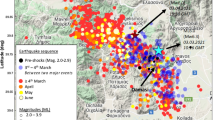Abstract
On 26th October 2015, an Mw 7.5 earthquake struck northern Pakistan, with its epicenter located 45 km southwest of Jarm in the Hindu Kush region of Afghanistan. The earthquake resulted from reverse faulting at a depth of 210 km, resulting in 280 fatalities and substantial damage to some 109,123 buildings. Regional seismicity, characteristics of recorded strong motions, damage statistics, and building performance observations are presented. Earthquake damage was mostly constrained to seismic-deficient unreinforced masonry (URM) buildings. Typical failure modes included toppled minarets, partial or complete out of plane collapse of URM walls, diagonal shear cracking in piers, flexural cracking in spandrels, corner damage, pounding damage, and damage due to ground settlement. The majority of human loss resulted due to failure of URM walls and subsequent roof collapse. URM buildings located in rural hilly areas closer to the epicenter suffered more intense and frequent damage than urban URM buildings located farther away in larger cities.
Similar content being viewed by others
References
Abrams DP (2000), “Seismic Response Patterns for URM Buildings,” The Masonry Society Journal, 18(1): 71–78.
ASCE (2013), ASCE 41-13: Seismic Evaluation and Retrofit of Existing Buildings, American Society of Civil Engineers, Reston, V.A.
Bothara JK and Hiçyilmaz KMO (2008), “General Observations of Building Behavior during the 8th October 2005 Pakistan Earthquake,” Bulletin of the New Zealand Society for Earthquake Engineering, 41(4): 209–233.
Chmyriov VM and Mirzad SH (1972), Geologic Map of Afghanistan, Department of Geology and Mines, Ministry of Mines and Industries of Royal Afghanistan: Kabul, Afghanistan.
DAWN (2014), 1945 Tsunami strikes Karachi coast, killing 4000, DAWN Media Group, Karachi, Pakistan.
Doherty K, Griffith MC, Lam N and Wilson J (2002), “Displacement-based Seismic Analysis for Out-of-plane Bending of Onreinforced Masonry Walls,” Earthquake engineering and structural dynamics, 31(4): 833–850.
ERRA (2006), Strategy Document Rural Housing Construction, Building Back Better: Rural Housing Reconstruction Strategy of Earthquake Hit Districts in NWFP and AJK, Earthquake Reconstruction and Rehabilitation Authority, Islamabad, Pakistan.
Ismail N, Griffith M and Ingham JM (2011), “Performance of Masonry Buildings during the 2010 Darfield (New Zealand) Earthquake,” Proceedings of the 11th North American Masonry Conference, Minneapolis, USA.
Ismail N (2012), “Selected Strengthening Techniques for the Seismic Retrofit of Unreinforced Masonry Buildings,” PhD Thesis, University of Auckland, Auckland, New Zealand.
Ismail N and Khattak N (2016), “Building Typologies Prevalent in Northern Pakistan and Their Performance during the 2015 Hindu Kush Earthquake,” Earthquake Spectra, 32(4): 2473–2493.
Ismail N (2016), “Performance of Wall to Diaphragm Anchors for Use in Seismic Upgrade of Heritage Masonry Buildings,” International Journal of Architectural Heritage, doi: 10.1080/15583058.2016.1144115.
Javed M, Khan AN and Magenes G (2008), “Performance of Masonry Structures during Earthquake-2005 in Kashmir,” Mehran University Research Journal of Engineering and Technology (Pakistan), 27(3):271–282.
Lam N, Wilson J and Hutchinson G (1995), “The Seismic Resistance of Unreinforced Masonry Cantilever Walls in Low Seismicity Areas,” Bulletin of the New Zealand National Society for Earthquake Engineering, 28(3): 179–195.
Magenes G and Calvi GM (1997), “In-plane Seismic Response of Brick Masonry Walls,” Earthquake Engineering and Structural Dynamics, 26(11): 1091–1112.
Maqsood ST and Schwarz J (2011), “Development of a Building Inventory and Vulnerability Database for Pakistan,” Australian Earthquake Engineering Society 2011 Conference, Barossa Valley, South Australia, Nov 18–20.
MOHW (2007), Building Code of Pakistan (Seismic Provisions 2007), Ministry of Housing and Works, Government of Pakistan, Islamabad, Pakistan.
Moon FL, Yi T, Leon RT and Kahn LF (2006), “Recommendations for Seismic Evaluation and Retrofit of Low-rise URM Structures,” Journal of Structural Engineering, 132(5): 663–672.
Moon FL, Dizhur D, Senaldi I, Derakhshan H, Griffith M, Magenes G and Ingham JM (2014), “The Demise of the URM Building Stock in Christchurch during the 2010–2011 Canterbury Earthquake Sequence,” Earthquake Spectra, 30(1): 253–276.
MSJC (2005), TMS 402-05: Building Code Requirements for Masonry Structures, American Society of Civil Engineers, Reston, USA.
Naseer A, Khan AN, Hussain Z and Ali Q (2010), “Observed Seismic Behavior of Buildings in Northern Pakistan during the 2005 Kashmir Earthquake,” Earthquake Spectra, 26(2): 425–449.
NCEG (2015), Strong Ground Motion Records of Peshawar, National Center for Excellence in Geology, University of Peshawar, Peshawar, Pakistan
NZSEE (2006), Assessment and Improvement of the Structural Performance of Buildings and Earthquakes, Recommendations of a NZSEE Study Group on Earthquake Risk Buildings, New Zealand Society for Earthquake Engineering, Wellington, New Zealand.
PBS (1998), Population Census Data (1998), Khyber Pakhtunkhwa District at a Glance, Pakistan Beaureu of Statistics, Islamabad, Pakistan. Available from http://www.pbs.gov.pk.
PDMA (2015), Report of Damages due to 26th October, 2015 Earthquake, Provincial Disaster Management Authority, Government of Khyber Pakhtunkhwa, Peshawar, Pakistan.
Shahzada K, Khan AN, Elnashai A, Ashraf M, Javed M, Naseer A and Alam B (2012), “Experimental Seismic Performance Evaluation of Unreinforced Brick Masonry Buildings,” Earthquake Spectra, 28(3): 1269–1290.
USGS (2005), Event Page: Magnitude 7.6 - Pakistan, United States Geological Survey, Reston, V.A.
USGS (2013), Event page: M7.7 - 61km NNE of Awaran, Pakistan, United States Geological Survey, Reston, V.A.
USGS (2015a), ANSS Comprehensive Catalog and Important Caveats, United States Geological Survey, Reston, V.A.
USGS (2015b), Event page: M7.5 - 45km E of Farkhar, Afghanistan, United States Geological Survey, Reston, V.A.
Wand Z (2008) “A Preliminary Report on the Great Wenchuan Earthquake,” Earthquake Engineering and Engineering Vibration, 7(2): 225–234.
Wheeler RL, Bufe CG, Johnson ML, Dart RL and Norton G (2005), Seismotectonic Map of Afghanistan, with Annotated Bibliography, United States Geological Survey, Reston, V.A.
Acknowledgement
The study reported herein was partially funded by the United Arab Emirates University under research grant G00001603. The authors thank Engr. Rajab Ali, Dr. Naveed Ahmad, and students of University of Engineering and Technology, Peshawar, for facilitating and participating in the damage assessment surveys. Feedback and information provided by a number of building practitioners, engineers, and building owners is also gratefully acknowledged.
Author information
Authors and Affiliations
Corresponding author
Rights and permissions
About this article
Cite this article
Ismail, N., Khattak, N. Observed failure modes of unreinforced masonry buildings during the 2015 Hindu Kush earthquake. Earthq. Eng. Eng. Vib. 18, 301–314 (2019). https://doi.org/10.1007/s11803-019-0505-x
Received:
Accepted:
Published:
Issue Date:
DOI: https://doi.org/10.1007/s11803-019-0505-x




